Chemical and Creep Models Applied to Concrete Damaged by Alkali–Silica Reactions
Abstract
:1. Introduction
- the use of reactive aggregate;
- an adequate level of alkalinity;
- sufficient moisture in the pores of concrete;
- high temperature.
Research Significance
2. Swelling and Cracking Mechanisms Related to ASR
2.1. Factors Influencing the Evolution of ASR
2.2. Numerical Modeling of ASR
3. Poromechanical Theory
3.1. Chemical Modelling
3.2. Creep Modelling
3.2.1. Permanent Creep—Maxwell Strain
3.2.2. Reversible Creep—Kelvin Strain
3.3. Implementation in COMSOL Multiphysics®
4. Results and Discussion
4.1. Results of the Chemical Model
4.2. Results of the Creep Model
5. Conclusions
- The impact of the characteristic time on the progress of the expansion reactions was found to be very similar to the experimental tests, given a degree of saturation of 100% and a temperature of 38 °C. However, the most significant difference between the numerical model and the experimental result was observed for a characteristic time of 50 days. This discrepancy can be attributed to the fact that the characteristic time plays a crucial role in determining the reaction kinetics from the beginning to the end of the swelling process. When the characteristic time is small, it indicates minimal expansion. Consequently, the numerical model struggles to accurately capture this phenomenon. Despite this limitation, the obtained results are still promising as the observed divergence is not substantial.
- The effect of temperature on the progress of expansion reactions, for a degree of saturation of 100% and a characteristic time of 50 days, was equally close to the experimental tests. The most pronounced difference between the numerical model and the experimental result was observed at a temperature of 10 °C. This behavior can be explained for the same reasons as mentioned above, as lower temperatures result in less progress of the reaction. For higher temperatures, the numerical model was closer to the experimental results.
- The effect of the degree of saturation showed the greatest discrepancies between the numerical models and experimental data. For a fixed temperature of 38 °C and a characteristic time of 50 days, the degree of saturation that led to the greatest differences was 50%. This discrepancy may be due to an alteration of the parameters presented in the lab tests, as the curves for the same parameters did not match.
- The uniaxial compression results showed a maximum discrepancy of approximately 10% between the simulation and experimental results, which is considered satisfactory for numerical simulations of the experimental benchmark.
- The biaxial compression results had a maximum discrepancy of approximately 13%, which is very close to the discrepancy found in the uniaxial compression comparison.
- The discrepancy observed in strain εI (parallel to stress σI) was higher than the discrepancy observed in strain εII (parallel to stress σII). This suggests that higher loads lead to higher discrepancies, as σI was 2.5 and five times higher than σII. Additionally, the discrepancy is higher for longer periods of time, as the creep strain increases with time.
Author Contributions
Funding
Data Availability Statement
Conflicts of Interest
References
- Comi, C.; Perego, U. Anisotropic damage model for concrete affected by alkali-aggregate reaction. Int. J. Damage Mech. 2011, 20, 598–617. [Google Scholar] [CrossRef]
- Silva, F.A.N.; Delgado, J.M.P.Q.; Azevedo, A.C.; Mahfoud, T.; Khelidj, A.; Nascimento, N.; Lima, A.G.B. Diagnosis and assessment of deep pile cap foundation of a tall building affected by internal expansion reactions. Buildings 2021, 11, 104. [Google Scholar] [CrossRef]
- Delgado, J.M.P.Q.; Nascimento, N.; Silva, F.A.N.; Azevedo, A.C. Diagnostic of Concrete Samples of Pile Caps Affected by Internal Swelling Reactions. Iran. J. Sci. Technol. Trans. Civ. Eng. 2021, 45, 1059–1071. [Google Scholar] [CrossRef]
- Silva, F.A.N.; Delgado, J.M.P.Q.; Azevedo, A.C.; Lira, I.S. Numerical analysis of bottle-shaped isolated struts concrete deteriorated by delayed ettringite formation. Iran. J. Sci. Technol. -Trans. Civ. Eng. 2021, 46, 169–184. [Google Scholar] [CrossRef]
- Silva, K.K.S.; Silva, F.A.N.; Mahfoud, T.; Khelidj, A.; Brientin, A.; Azevedo, A.C.; Delgado, J.M.P.Q.; De Lima, A.G.B. On the use of embedded fiber optic sensors for measuring early-age strains in concrete. Sensors 2021, 21, 4171. [Google Scholar] [CrossRef]
- Matos, A.M.; SILVA, F.A.N.; Azevedo, A.C.; Marins, J.F.; Delgado, J.M.P.Q. Alkali-reactivity of Pernambuco east shear zone coarse concrete aggregates: An experimental discussion. Constr. Build. Mater. 2022, 344, 128239. [Google Scholar] [CrossRef]
- Rajabipour, F.; Giannini, E.; Ideker, J.H.; Dunant, D.F. Alkali-silica reaction: Current understanding of the reaction mechanisms and the knowledge gaps. Cem. Concr. Res. 2015, 76, 130–146. [Google Scholar] [CrossRef]
- Grimal, E.; Sellier, A.; Le Pape, Y.; Bourdarot, E. Creep, shrinkage, and anisotropic damage in alkali-aggregate reaction swelling mechanism—Part I: A constitutive model. ACI Mater. J. 2007, 105, 227–235. [Google Scholar]
- Pan, J.W.; Feng, Y.T.; Wang, J.T.; Sun, Q.C.; Zhang, C.H.; Owen, D.R.J. Modeling of alkali-silica reaction in concrete: A review. Struct. Civ. Eng. 2012, 6, 1–18. [Google Scholar] [CrossRef]
- Thomas, M.; Folliard, K.; Drimalas, T.; Ramlochan, T. Diagnosing delayed ettringite formation in concrete structure. Cem. Concr. Res. 2008, 38, 841–847. [Google Scholar] [CrossRef]
- Broekmans, M.A. Guest editorial. Cem. Concr. Res. 2010, 40, 501. [Google Scholar] [CrossRef]
- Jensen, V. Alkali-silica reaction damage to Elgeseter Bridge, Trondheim, Norway: A review of construction, research and repair up to 2003. Mater. Charact. 2004, 53, 155–1770. [Google Scholar] [CrossRef]
- Ghannadi, P.; Kourehli, S.S.; Mirjalili, S. A review of the application of the simulated annealing algorithm in structural health monitoring (1995–2021). Frat. Ed. Integrità Strutt. 2023, 17, 51–76. [Google Scholar] [CrossRef]
- Thomas, M.D.A.; Fournier, B.; Folliard, K.J. Alkali-Aggregate Reactivity (AAR) Facts Book; Report No. FHWA-HIF-13-019; U.S. Department of Transportation—Federal Highway Administration: Springfield, VA, USA, 2013; 211p.
- Ponce, J.; Batic, O. Different manifestations of the alkali-silica reaction in concrete according to the reaction kinetics of the reactive aggregate. Cem. Concr. Res. 2006, 36, 148–1156. [Google Scholar] [CrossRef]
- Idorn, G.M. A discussion of the paper “Mathematical model for kinetics of alkali-silica reaction in concrete” by Z.P. Bazănt and A. Steffens. Cem. Concr. Res. 2001, 31, 1109–1110. [Google Scholar] [CrossRef]
- Garcia-Diaz, E.; Riche, J.; Bulteel, D.; Vernet, C. Mechanism of damage for the alkali–silica reaction. Cem. Concr. Res. 2006, 36, 395–400. [Google Scholar] [CrossRef]
- Ichikawa, T.; Miura, M. Modified model of alkali-silica reaction. Cem. Concr. Res. 2007, 37, 1291–1297. [Google Scholar] [CrossRef]
- Pourbehi, M.S. Numerical Modelling of Alkali Silica Reaction in Concrete Dams. Ph.D. Thesis, Stellenbosch University, Stellenbosch, WC, South Africa, 2018. [Google Scholar]
- Morenon, P. Modélisation des Reactions de Gonflement Interne des Bétons Avec Prise en Compte des Couplages Poro-Mécaniques et Chimiques. Ph.D. Thesis, Université Toulouse 3 Paul Sabatier, Toulouse, France, 2017. [Google Scholar]
- Gao, X.X.; Multon, S.; Cyr, M.; Sellier, A. Alkali-silica reaction (ASR) expansion: Pessimum effect versus scale effect. Cem. Concr. Res. 2013, 44, 25–33. [Google Scholar] [CrossRef]
- Multon, S.; Cyr, M.; Sellier, A.; Diederich, P.; Petit, L. Effects of aggregate size and alkali content on ASR expansion. Cem. Concr. Res. 2010, 38, 350–359. [Google Scholar] [CrossRef]
- Larive, C. Apports Combinés de L’expérimentation et de la Modélisation à la Compréhension de L’alcali-Réaction et de Ses effects Mécaniques. Ph.D. Thesis, Ecole Nationale des Ponts et Chaussées, Paris, France, 1997. [Google Scholar]
- Ulm, F.J.; Coussy, O.; Larive, C.; Kefei, L. Thermo-chemo-mechanics of ASR expansion in concrete structures. J. Eng. Mech. 2000, 126, 233–242. [Google Scholar] [CrossRef]
- Multon, S. Évaluation Expérimentale et Théorique des Effects Mécaniques de L’alcali-Réaction sur des Structures Modèles. Ph.D. Thesis, Université de Marne-la-Vallée, Marne-la-Vallée, Île-de-France, France, 2003. [Google Scholar]
- Multon, S.; Toutlemonde, F. Effect of applied stresses on alkali-silica reaction induced expansions. Cem. Concr. Res. 2006, 36, 912–920. [Google Scholar] [CrossRef]
- Dunant, C.F.; Scrivener, K.L. Effects of uniaxial stress on alkali-silica reaction induced expansion of concrete. Cem. Concr. Res. 2012, 42, 567–576. [Google Scholar] [CrossRef]
- Gautam, B.P.; Panesar, D.K. A new method of applying long-term multiaxial stresses in concrete specimens undergoing ASR, and their triaxial expansions. Mater. Struct. 2016, 49, 3495–3508. [Google Scholar] [CrossRef]
- Sellier, A.; Multon, S.; Buffo-Lacarrière, L.; Vidal, T.; Bourbon, X.; Guillaume, C. Concrete creep modelling for structural applications: Non-linearity, multi-axiality, hydration, temperature and drying effects. Cem. Concr. Res. 2016, 79, 301–315. [Google Scholar] [CrossRef]
- COMSOL Muliohysics® v. 5.5. COMSOL AB, Stockholm, Sweden. Available online: www.comsol.com (accessed on 18 February 2023).
- Kim, S.Y.; Kim, J.K.; Kim, Y.Y.; Kwon, S.H. Experimental studies on creep of sealed concrete under multiaxial stresses. Mag. Concr. Res. 2005, 57, 623–634. [Google Scholar] [CrossRef]
- Ladaoui, W.; Vidal, T.; Sellier, A.; Bourbon, X. Analysis of interactions between damage and basic creep of HPC and HPFRC heated between 20 and 80 °C. Mater. Struct. 2013, 46, 13–23. [Google Scholar] [CrossRef]
- Sellier, A.; Casaux-Ginestet, G.; Buffo-Lacarrière, L.; Bourbon, X. Orthotropic damage coupled with localized crack reclosure processing—Part I: Constitutive laws. Eng. Fract. Mech. 2013, 971, 148–1673. [Google Scholar] [CrossRef]


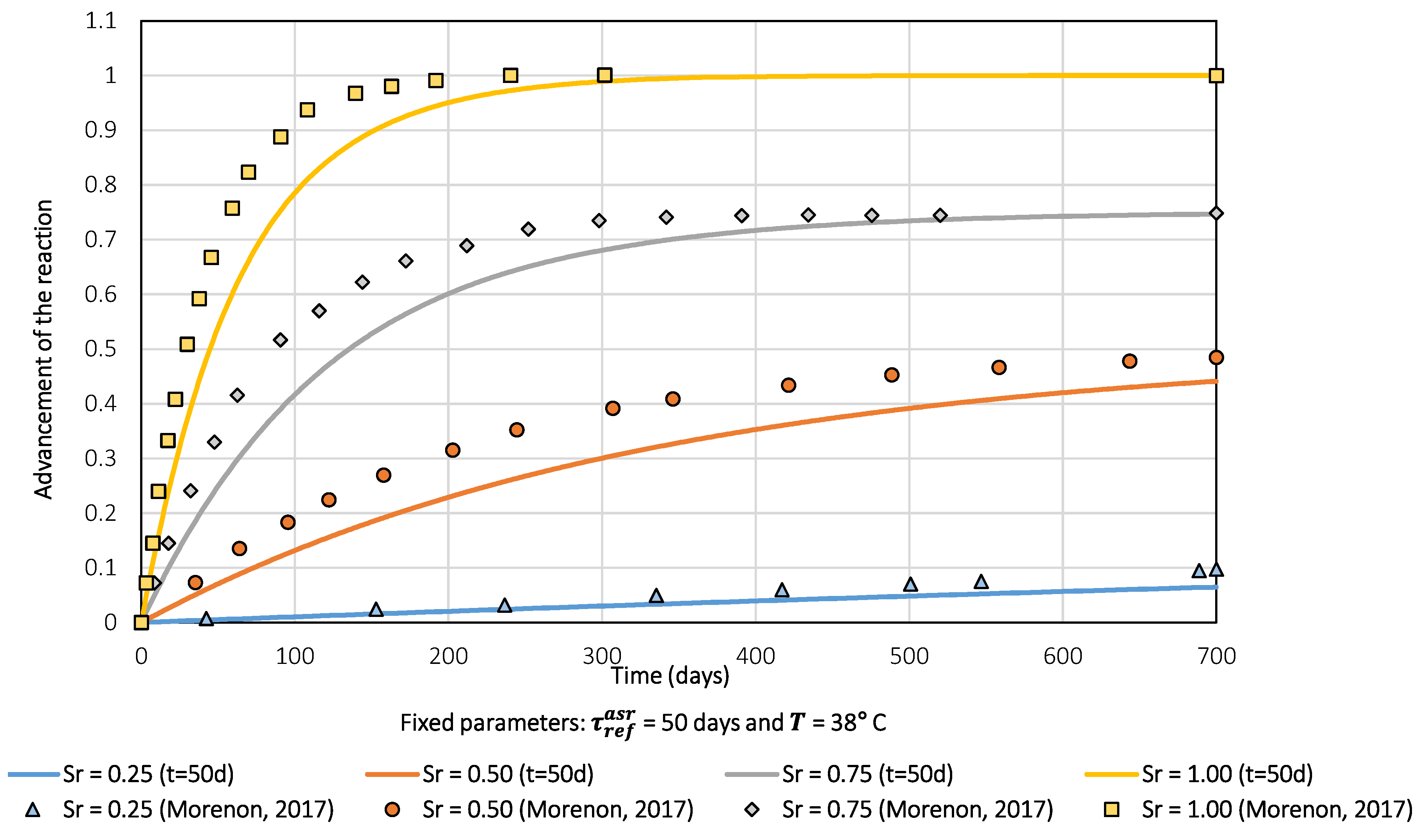
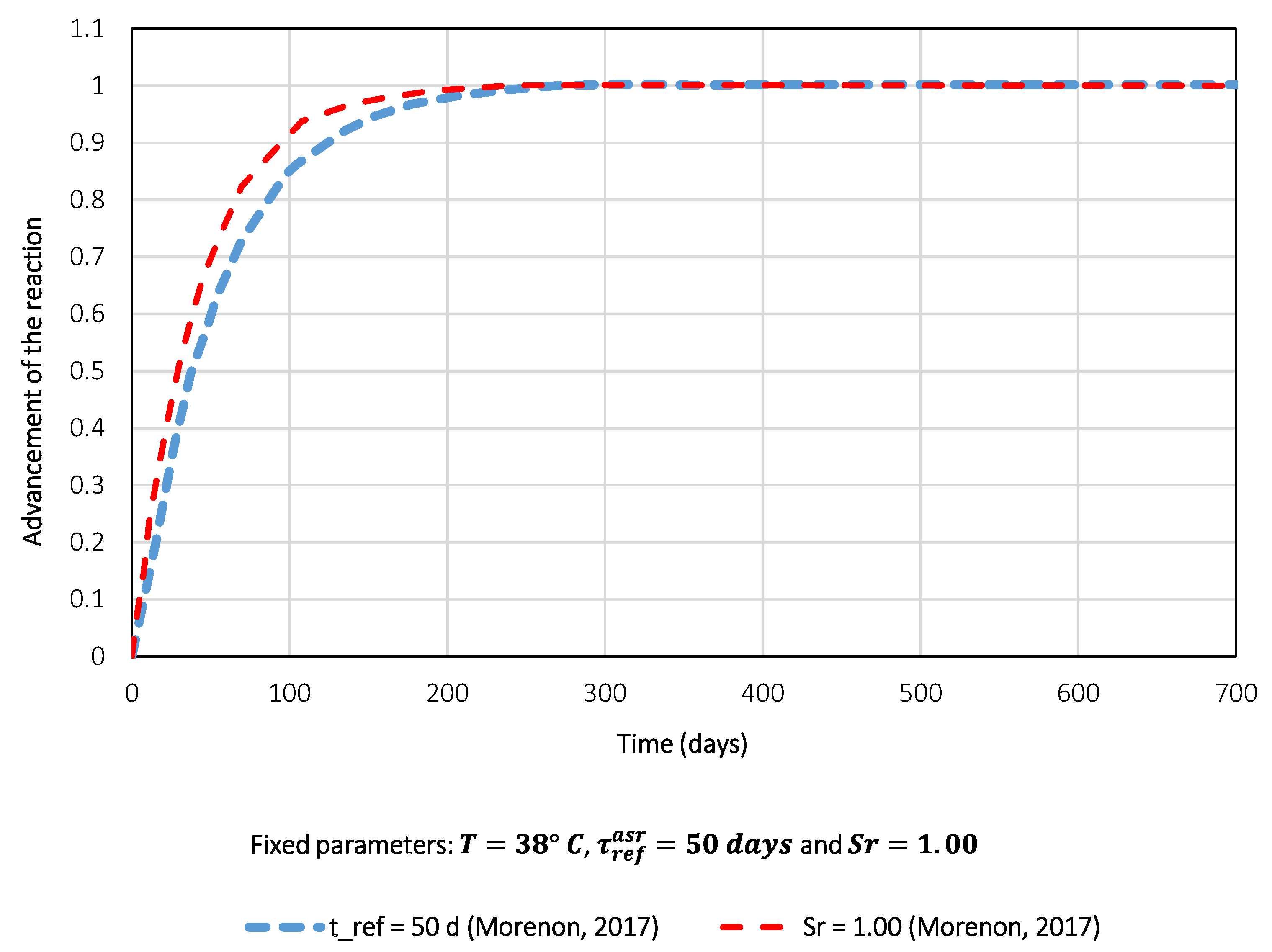

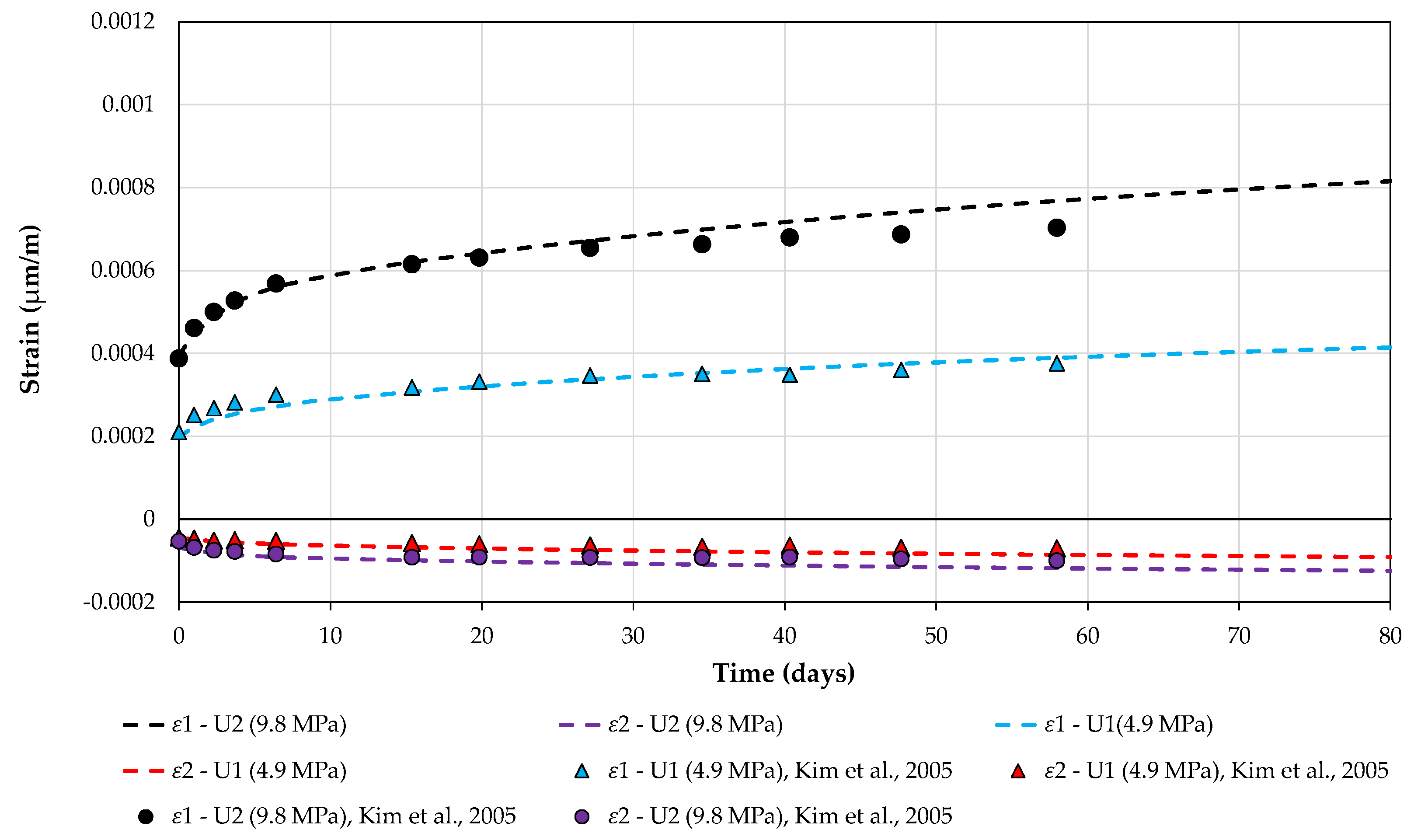
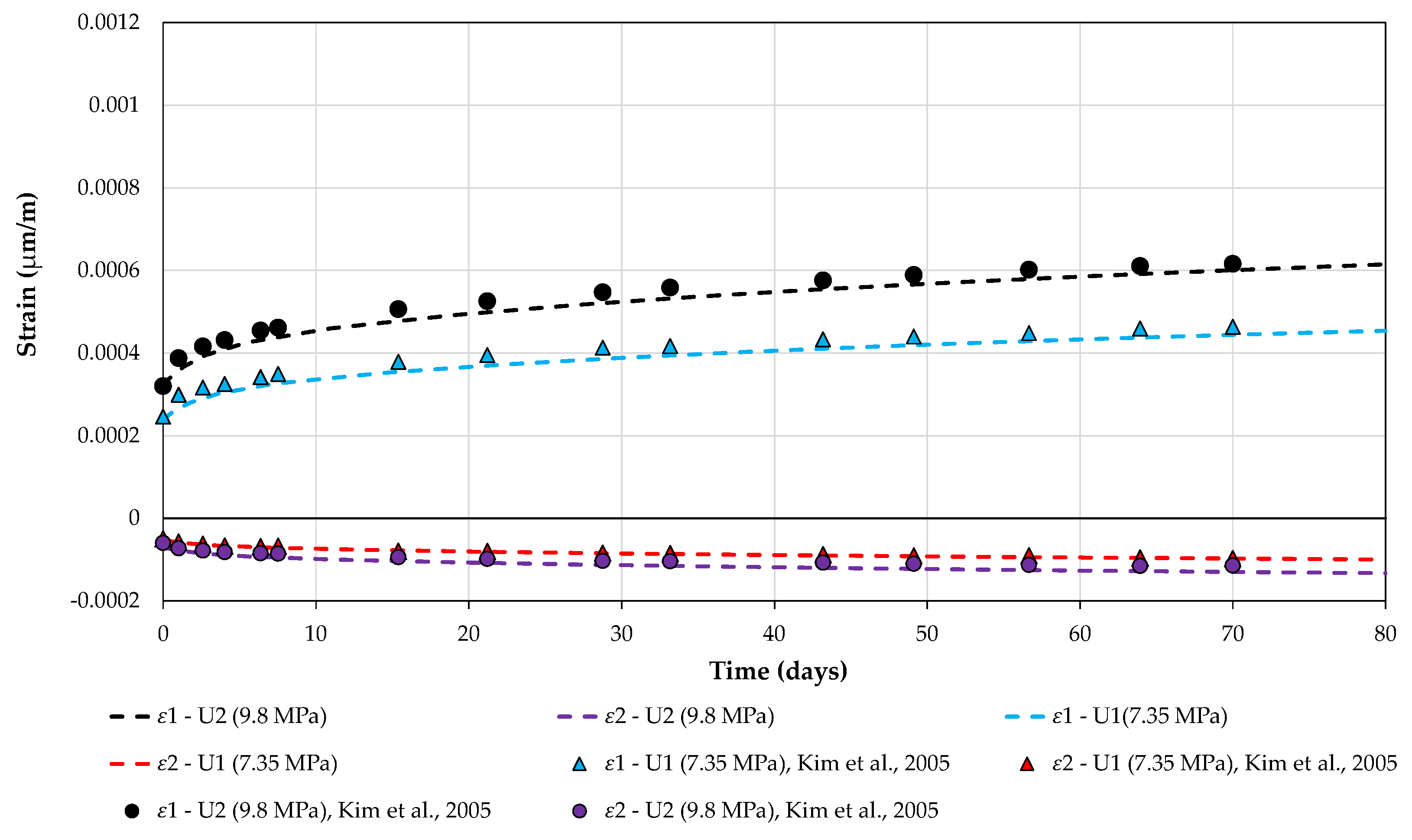

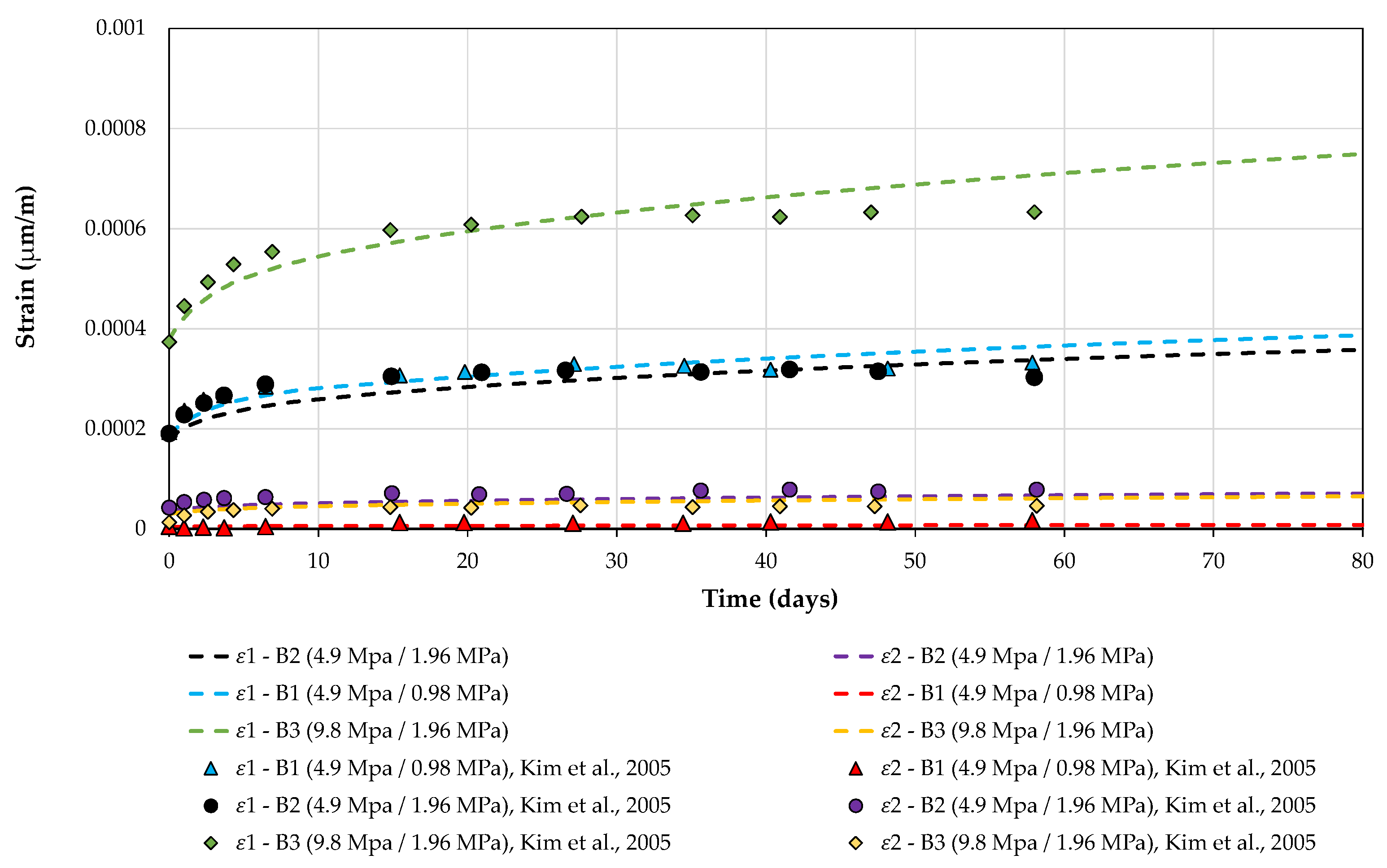
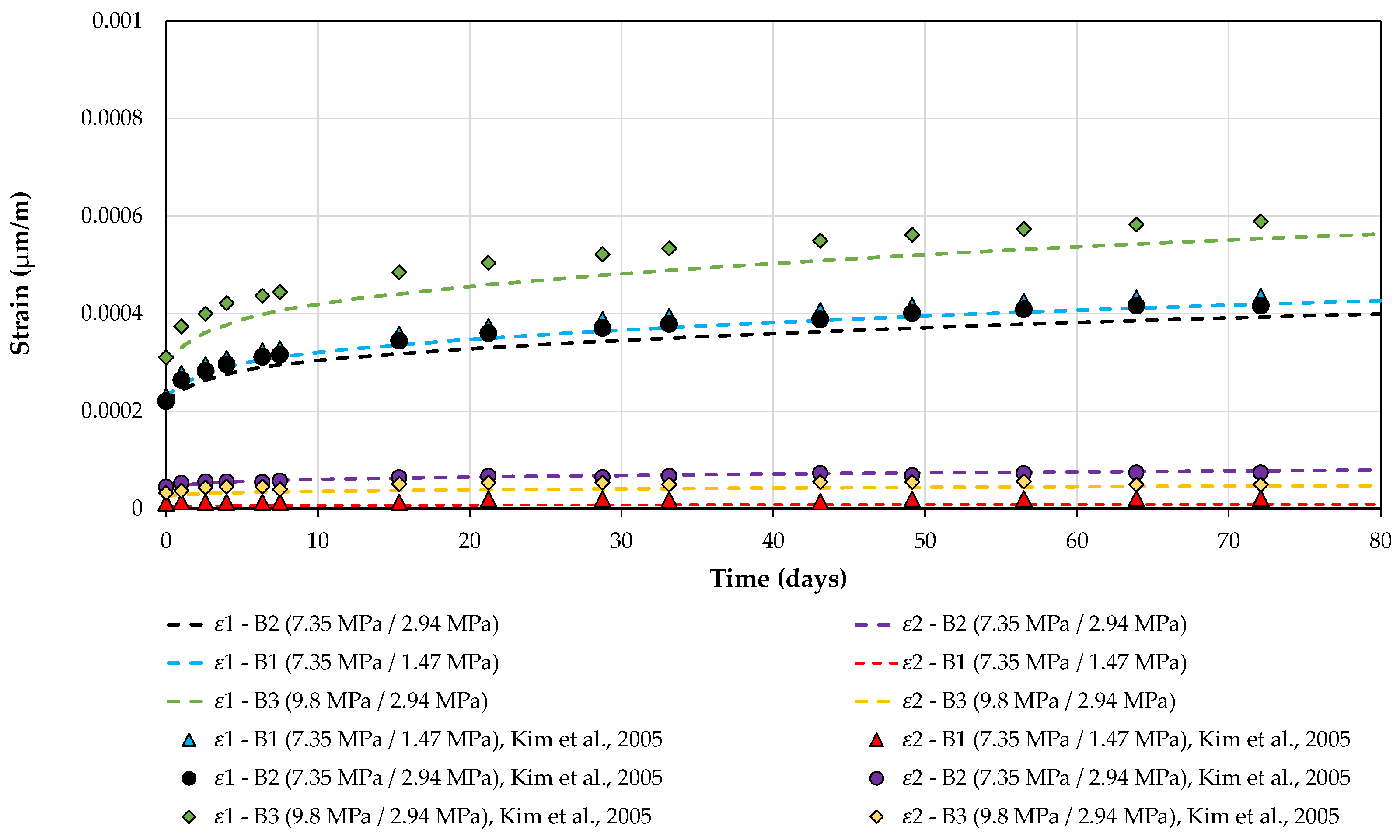

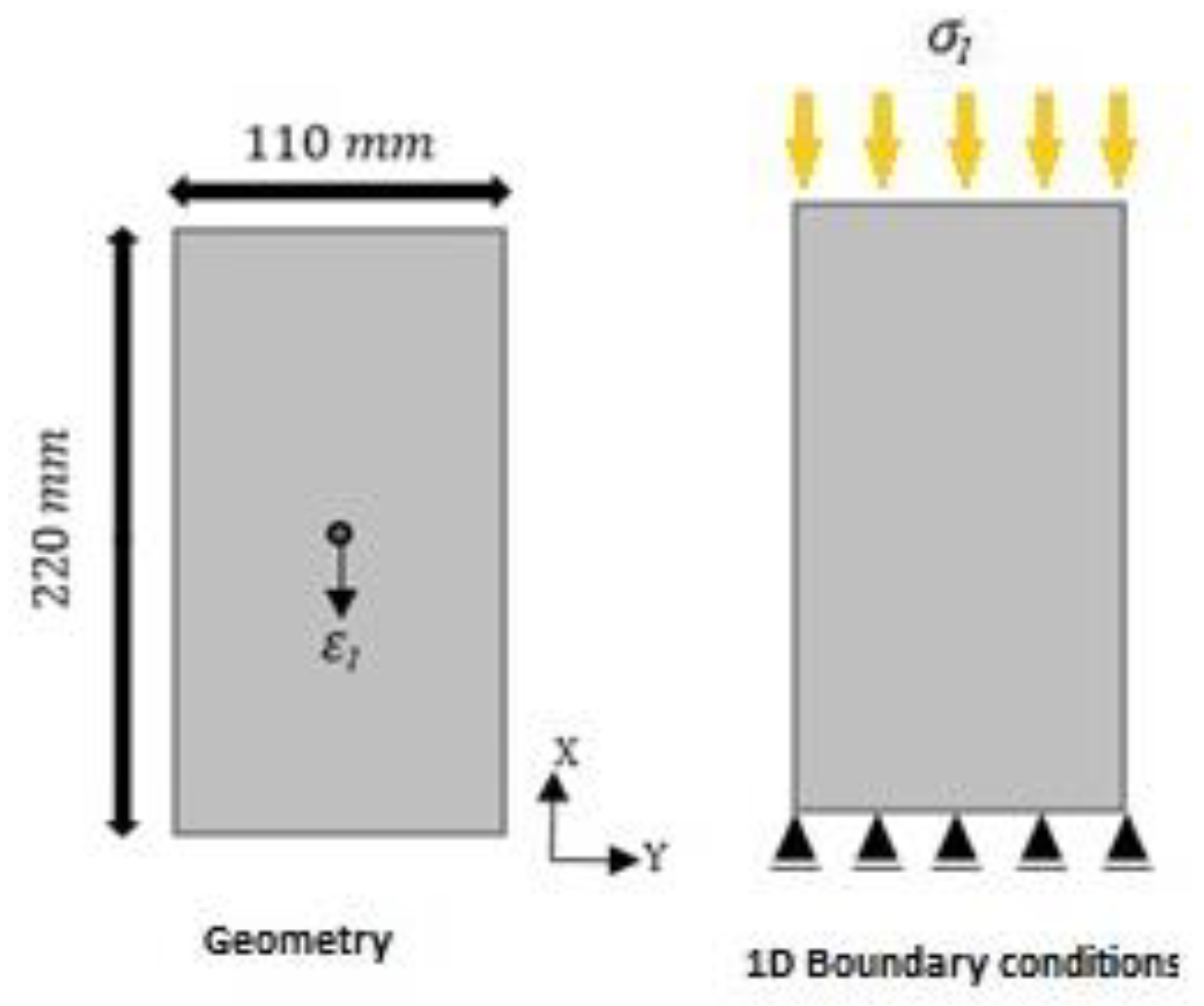
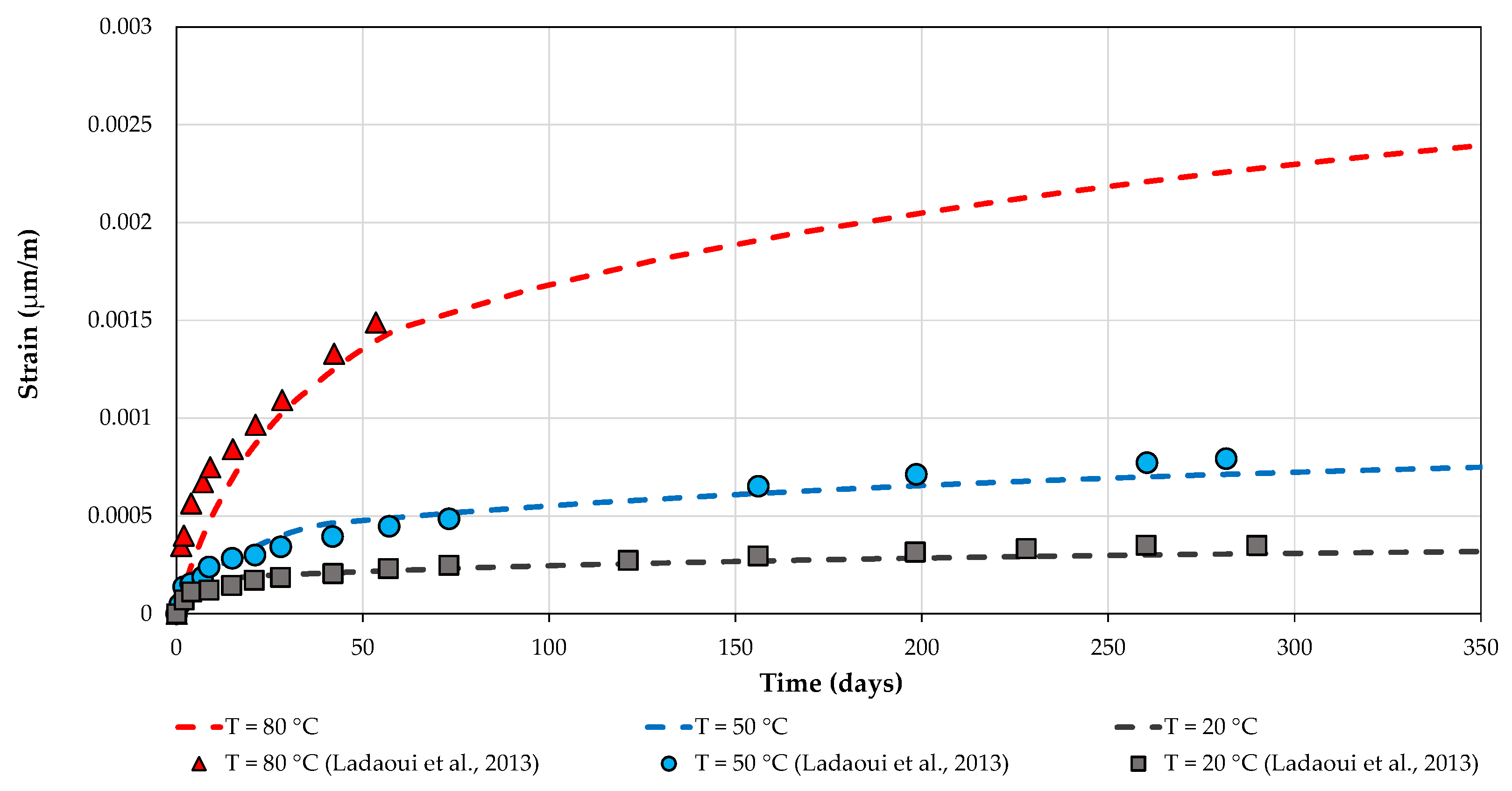
| Parameter | Meaning | Range Value in Laboratory Tests | Unit of Measure | Calibration Test |
|---|---|---|---|---|
| Maximum volume ratio of ASR gel | m³/m³ | Free-swelling test | ||
| Characteristic time of ASR | Days | Free-swelling test | ||
| Saturation degree threshold to activate ASR | - | Swelling test for different hydric conditions | ||
| Reference temperature at which the test is carried out | Temperature value | - | ||
| Activation energy for the kinetics of ASR | J/mol | Swelling test for different temperatures |
| Parameter | Meaning | Range in Laboratory Tests | Unit of Measure | Calibration Test |
|---|---|---|---|---|
| Volume of porosity connected to the reactive sites | m³/m³ | Free-swelling test | ||
| Biot coefficient for ASR | - | Restrained swelling test | ||
| Biot modulus for gel–matrix interaction | MPa | Free-swelling test |
| Parameter | Meaning | Range Value in Laboratory Tests | Unit of Measure |
|---|---|---|---|
| Reference characteristic time associated with the Maxwell strain | Days | ||
| Activation energy for water viscosity | J/mol | ||
| Activation energy for differential dilatation between phases | J/mol | ||
| Reference temperature for which is fitted | °C | ||
| Temperature threshold for which the thermal damage appears and modifies the creep potential | °C | ||
| Fitting parameter responsible for the non-linear behavior when the specific creep amplification increases with the loading rate. | 2 | - | |
| Reference creep coefficient | - |
| Parameter | Meaning | Range Value in Creep Tests | Unit of Measure |
|---|---|---|---|
| Fitting parameter to control the kinetics modification, adjusting the final amplitude of the reversible creep | - | ||
| Reference characteristic time associated with the Kelvin strain | days |
| Concrete Compressive Strength (MPa) | Uniaxial Compression | Biaxial Compression | |||
|---|---|---|---|---|---|
| Stress Level 1 (MPa) | Stress Level 2 (MPa) | Stress Level 1 (MPa) | Stress Level 2 (MPa) | Stress Level 3 (MPa) | |
| 26 | = 4.9 | = 9.8 | = 4.9 = 0.98 | = 4.9 = 1.96 | = 9.8 = 1.96 |
| 44 | = 7.35 | = 9.8 | = 7.35 = 1.47 | = 7.35 = 2.94 | = 9.8 = 2.94 |
| 54 | = 9.8 | = 12.25 | = 9.8 = 1.96 | = 9.8 = 3.92 | = 12.25 = 3.92 |
| Concrete# | Parameter | Value |
|---|---|---|
| C1 | fc (MPa) | 26 |
| (MPa) | 24.010 | |
| 0.18 | ||
| (days) | 2 | |
| (days) | 15 | |
| 10 × 10−5 | ||
| 4 | ||
| 211 × 10−6 | ||
| C2 | fc (MPa) | 44.1 |
| (MPa) | 29.841 | |
| 0.18 | ||
| (days) | 2 | |
| (days) | 15 | |
| 9 × 10−5 | ||
| 4 | ||
| 246 × 10−6 | ||
| C3 | fc (MPa) | 54.3 |
| (MPa) | 34.006 | |
| 0.18 | ||
| (days) | 3 | |
| (days) | 20 | |
| 7.5 × 10−5 | ||
| 4 | ||
| 288 × 10−6 |
| Parameter | Value |
|---|---|
| fc (MPa) | 86 |
| (T = 20 °C) (MPa) | 34.800 |
| (T = 50 °C) (MPa) | 41.600 |
| (T = 80 °C) (MPa) | 45.450 |
| 0.28 | |
| (J/mol) | 23.700 |
| (days) | 5 |
| (days) | 10 |
| 5.5 × 10−5 | |
| 5 | |
| 590 × 10−6 |
Disclaimer/Publisher’s Note: The statements, opinions and data contained in all publications are solely those of the individual author(s) and contributor(s) and not of MDPI and/or the editor(s). MDPI and/or the editor(s) disclaim responsibility for any injury to people or property resulting from any ideas, methods, instructions or products referred to in the content. |
© 2023 by the authors. Licensee MDPI, Basel, Switzerland. This article is an open access article distributed under the terms and conditions of the Creative Commons Attribution (CC BY) license (https://creativecommons.org/licenses/by/4.0/).
Share and Cite
Roma, R.F.; Silva, F.A.N.; Bourbatache, M.K.; Tahlaiti, M.; Delgado, J.M.P.Q.; Azevedo, A.C. Chemical and Creep Models Applied to Concrete Damaged by Alkali–Silica Reactions. Buildings 2023, 13, 2575. https://doi.org/10.3390/buildings13102575
Roma RF, Silva FAN, Bourbatache MK, Tahlaiti M, Delgado JMPQ, Azevedo AC. Chemical and Creep Models Applied to Concrete Damaged by Alkali–Silica Reactions. Buildings. 2023; 13(10):2575. https://doi.org/10.3390/buildings13102575
Chicago/Turabian StyleRoma, Rodrigo F., Fernando A. N. Silva, Mohamed K. Bourbatache, Mahfoud Tahlaiti, João M. P. Q. Delgado, and António C. Azevedo. 2023. "Chemical and Creep Models Applied to Concrete Damaged by Alkali–Silica Reactions" Buildings 13, no. 10: 2575. https://doi.org/10.3390/buildings13102575






